Road to Agility: Questions and Answers
Having read “The Road to Agility - One Step at a Time” article on this blog recently, we will be asking the author some questions. The answers should make us understand how to approach and execute each step in the process. The “Agility Roadmap” graphic in Figure 1 below will serve as a reference for the questions.
Starting with step 1.
Figure 1: The Agility Roadmap provides the step-by-step guide to achieve Agility
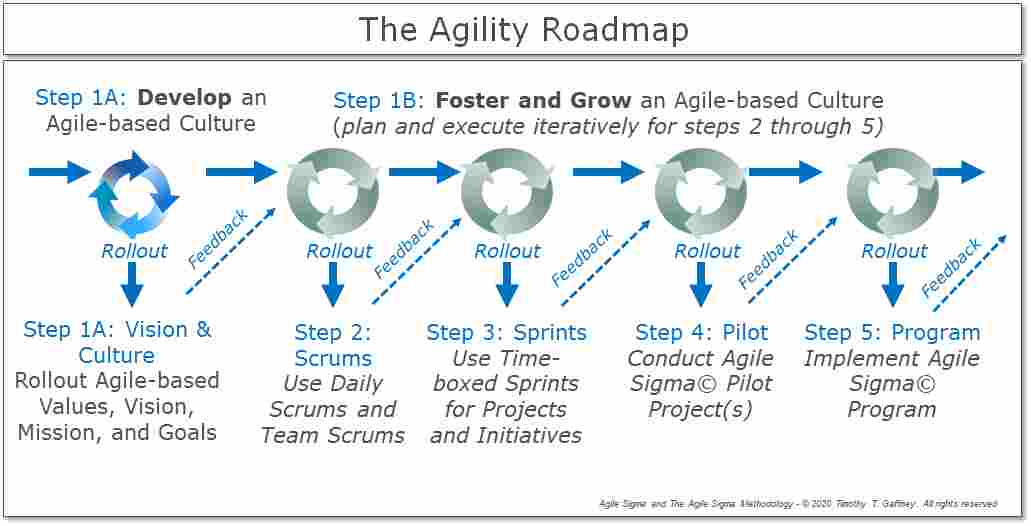
A. The Art and Science of Developing and Fostering an Agile-based Culture (Step 1)
Q: What’s the most important thing to consider when you start down the Road to Agility?
A: You have to understand throughout the journey that growing an Agile culture is both an art and a science.
The “science” includes:
- Researching agile-based values
- Running a survey to collect current customers, and employee input and feedback
- Updating vision statements
- Rolling out Scrums, etc.
The “art,” handles working within the existing cultures and management styles to overcome organizational inertia. This is the hard part because it takes care of any resistance to change. You must keep building momentum to develop your organization’s agility.
Q: What’s the best way to organize your agile-based planning team?
A: Start with a small multi-disciplinary, multi-level team. You can then execute Step 1A (develop an Agile-based Culture) by developing and launching agile-based plans starting with values, then vision, mission, and goals.
Proceed to iteratively use Step 1B (Foster and Grow Agile-based Values) to launch a full tile-based Program with Scrums, Sprints, and Pilot Projects.
Then expand the team to include more groups as you begin to roll out agile-based values. You must carry the key stakeholders along throughout the process to gain input, feedback, and support.
Q: What other leadership skills and techniques are helpful to initiate and sustain the process?
A: Flexibility and Responsiveness.
The ability to adjust plans as you get feedback at every step along the path. “Walk the walk” by using agile-based tools such as Scrums and Sprints to rollout work and plan your team’s task. For example, A two-weeks Sprint with Daily Scrums can be used to plan the rollout of the use of Scrums.
B. Using Scrums to Stimulate Adoption of Agile-based Values (Step 2)
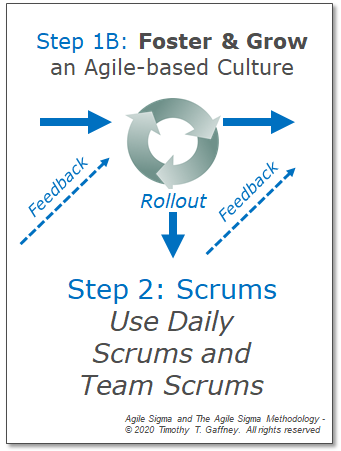
Q: How would you suggest using Scrums to maximize the teams’ benefits?
A: The goal is to use Scrums to:
Create a sense of common goals, alignment, and mutual cooperation within teams. Let them operate with an attitude that says “we’re all in this together and we’re all going to make it happen for the customer”.
- Stimulate the adoption of agile-based values
- Communicate and coordinate daily (Daily Scrum)
- Collaborate to accomplish work as needed (Team Scrum)
Q: What about when geography is involved?
A: For teams that are geographically dispersed, the Daily Scrum can be the key touchpoint every day with all team members. They can raise questions or ask for assistance at that time.
Be flexible when picking the Scrum timeframe and adjust as needed.
Q: What’s a good example of using Scrums to accomplish a particular team goal or objective?
A: During a Daily Scrum, members of a team or group may decide to work together for hours daily. It might even take a number of days to accomplish a goal. A Team Scrum approach will work well for that situation.
You start with a specific goal, agree on a time-frame to work together, and the right skillsets represented in the Team Scrum to get the job done.
C. Using Sprints to Foster the Growth of an Agile Culture
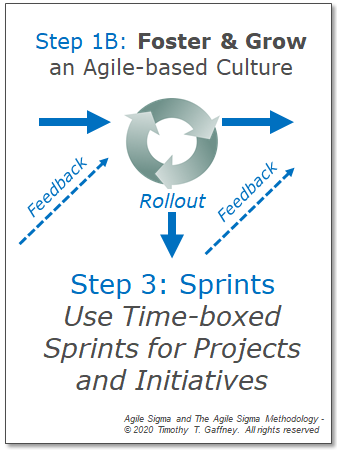
Q: What time frame would you suggest for Sprints (one, two, or three weeks)?
A: The process has no standard timeframe. You can start with a two-week Sprints, then make adjustments based on the team’s performance. Each team can decide their Sprint interval and work incrementally in that timeframe.
Shorter Sprints can be more helpful if there is a sense of urgency, high levels of customer oversight, or other time constraining factors.
Q: Would you suggest using Back-to-Back Sprints or Intermittent Sprints, i.e., with 1-2 weeks in between Sprints?
A: That depends on how committed the team members are. Back-to-back Sprints can be the best option for committed team members (assuming they commit more than 50 percent of their time to the project or initiative). While intermittent Sprints can be better for lower commitment levels (assuming they commit less than 50 percent of their time to the project).
Q: What’s the most important step in conducting a Sprint?
A: The Sprint Retrospective meeting is very important. The team uses inputs from the feedback to improve their process and optimize results in each successive Sprint. That’s the importance of the retrospective meeting.
Q: How does one maximize the benefits of using Sprints?
A: You can maximize benefits with Sprint if you:
- Develop a “Repository of Results” from Sprint Review and Retrospective Meetings. Share these across teams using Sprints to expand the use of best practices.
- Share and reward the successful use of Sprints by the project and initiative teams.
- During the Sprint planning meeting, use the Sprint Review meetings to plan each successive Sprint.
- Utilize Sprints iteratively on projects, for teams to deliver improved results faster.
Q: Can you describe an example where you used multiple Sprints to meet project goals more quickly?
A: We once utilized the multiple Sprints for a Project team that was charged with outside manufacturing capacity. It reduced the operational bottlenecks in many resource groups that caused customer delay.
Initially, the team had made limited progress during the first six weeks of the project. After being engaged to help the team, we adopted a two-week Sprint approach. Then we ran four Sprints to speed up results and end customer delay (see Figure 2 below).
The result included the team clocking 1,100 hours per month of resource capacity - increasing the amount of work sent to partners by 167 percent. We also documented and implemented new roles and procedures to manage new partner-related processes.
Figure 2: Example of Multiple Sprints to accelerate the accomplishment of project goals
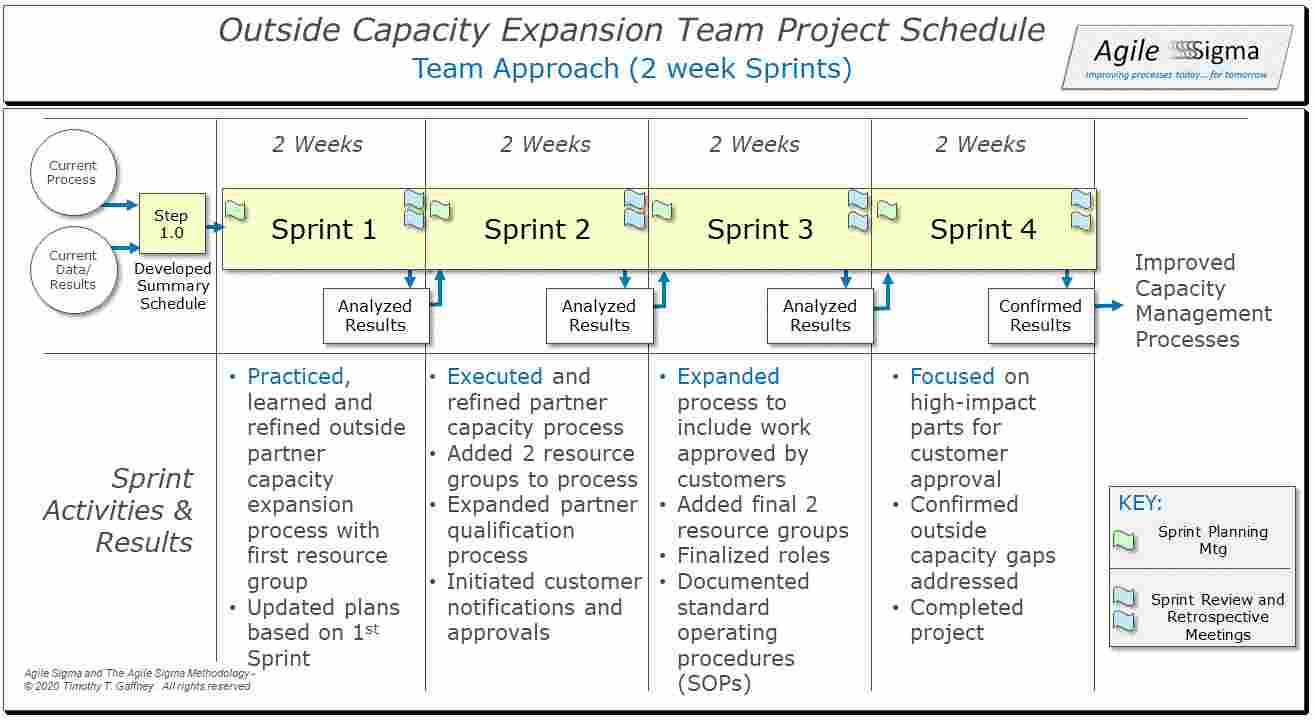
D. Key Insights for Running Pilot Projects to Solidify your Agile Culture (Step 4)
Q: What are the 3 most important things when planning Pilot Projects?
A: Selection, Selection, Selection.
- Selecting the right projects
- Selecting the right leadership and teams
- Selecting the right organizations to run the pilot projects
Q: What are some other key aspects of planning and executing pilots?
A: You have to:
- Set expectations properly with involved stakeholders
- Get the proper Agile Sigma© training and support
- Be agile as you plan. Develop iterative plans and refine them as needed.
- Manage the pilot projects carefully – Let the Sprints run! Don’t overmanage.
- Demonstrate support for the pilot projects. Participate in training, meetings, etc.
Q: Why is running agile-based pilot projects important to solidifying an agile culture?
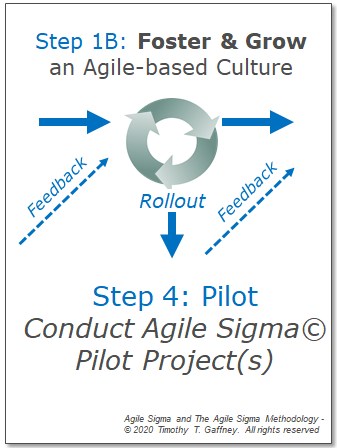
A: When you plan and execute pilot projects using an agile-based methodology like Agile Sigma©, it provides you with a test case scenario. It will show your organization how to achieve customer-driven performances, by improving its processes.
Pilot Projects also provide financial baseline information. This serves as a guide for planning an agile-based improvement program to grow a mature agile culture ( see Step 5 below).
E. How to Develop a Mature Agile Culture to Optimize Customer Benefits (Step 5)
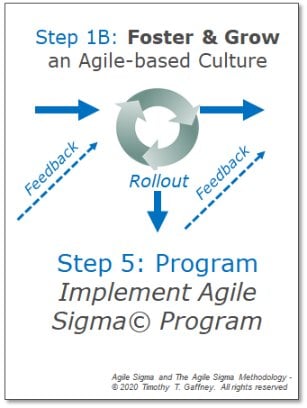
Q: How would you stimulate the maturation of an agile culture across your organizations?
A: You can use the Agile Sigma© program to build on the successes of your project. Routinize the use of agile tools and techniques in standard repeatable project framework across multiple organizations. You can also use it to stimulate your agile culture to mature
Project teams can use it to develop their agile skills and capabilities. They do this through repeated use of the methodology to optimize processes in response to their customers’ changing needs and business conditions.
Q: Why an Agile Sigma© Program?
A: A program that utilizes the Agile Sigma Methodology© provides you with the ability to:
Prioritize and select projects to address your most critical customer needs
Identify the key customer-impacting processes to be optimized via Agile Sigma© projects
Quantify, track, and accrue the financial benefits from the projects after completion
Q: What are the most important planning steps to establish an Agile Sigma© Program?
A: The key is The ability to plan and launch an Agile Sigma© program and make it a part of an existing program. You can first use it selectively as an option. Then more frequently as training proceeds and teams become more familiar with the project methodology.
Do you currently have an existing Six Sigma or Agile Centre of Excellence managing your programs and projects? Then you’re in an excellent place to integrate with the new program. It shows that you can leverage existing skill sets, program processes, and infrastructure to facilitate, plan, and speed up the process.
So, be agile as you go agile!
Q: What are the keys to providing effective support for the new Program?
A: Be involved every day. Provide appropriate formal and informal rewards and recognitions as you grow your agile culture. Acknowledge agile-based behaviors and outcomes that benefit your customers as the “fuel” that grows your agile culture over time.
Next Steps
Final question: As your Agile Sigma© Program helps to foster a mature agile culture throughout your organization, what suggestions do you have to progress further down the Road to Agility?
Final Answer: Using what you have learned, repeat processes iteratively to fine-tune your value system. It’s peculiar for each company, organization, or group.
Start again at Step One. Then, continue to maximize your customer’s benefit by iteratively evolving your agile-based toolkit, processes, etc within your Agile Sigma© Program. Go where your customers want you to go.